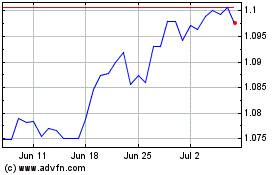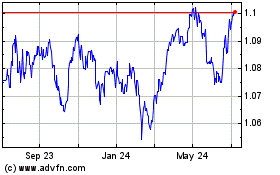Australian, Canadian Dollars Rise Amid Rising Risk Appetite
October 08 2015 - 8:36PM
RTTF2
The Australian and the Canadian dollars strengthened against
their major counterparts in the Asian session on Friday, tracking
the overnight surge in crude oil prices and the gains on Wall
Street after minutes of the latest Federal Reserve meeting
reinforced the view that the central bank may delay its first
interest rate hike into next year.
In the minutes, most officials decided it would be "prudent" to
wait for signs that problems overseas, especially in China, would
dissapate. The Fed voted 9 to 1 to hold rates steady.
The crude oil prices surged on upbeat demand growth outlook and
after the Federal Reserve's September meeting minutes hinted the
central bank will keep interest rates near zero for the next few
months. Crude oil for November delivery are currently up $0.25 to
$49.68 a barrel.
Oil prices hit a three-month high on Thursday after PIRA Energy
Group said a "new capital discipline" in the industry will allow
demand to catch up with supplies and boost prices to $70 per barrel
by the end of 2016.
In other economic news, data from the Australian Bureau of
Statistics showed that the total number of home loans issued in
Australia was up a seasonally adjusted 2.9 percent on month in
August, coming in at 54,546. That missed forecasts for an increase
of 4.7 percent following the downwardly revised 0.3 percent decline
in July.
Thursday, the Australian dollar showed mixed performance against
its major rivals. While the aussie rose against the greenback and
the yen, it fell against the euro.
Meanwhile, the Canadian dollar fell 0.02 percent against the
U.S. dollar, 0.26 percent against the yen and 0.34 percent against
the euro.
In the Asian trading, the Australian dollar rose to more than a
3-week high of 87.28 against the yen and a 3-week high of 0.7276
against the U.S. dollar, from yesterday's closing quotes of 87.06
and 0.7259, respectively. If the aussie extends its uptrend, it is
likely to find resistance around 89.00 against the yen and 0.73
against the greenback.
Against the euro and the NZ dollar, the aussie advanced to more
than a 1-1/2-month high of 1.5496 and a 2-day high of 1.0907 from
yesterday's closing quotes of 1.5529 and 1.0882, respectively. The
aussie may test resistance near 1.51 against the euro and 1.10
against the kiwi.
The Canadian dollar rose to 2-day highs of 1.2976 against the
U.S. dollar and 92.43 against the yen, from yesterday's closing
quotes of 1.3015 and 92.13, respectively. If the loonie extends its
uptrend, it is likely to find resistance around 1.28 against the
greenback and 95.00 against the yen.
Against the euro, the loonie advanced to a 2-day high of 1.4630
from yesterday's closing value of 1.4675. The loonie may test
resistance near the 1.43 region.
The loonie edged up to 0.9431 against the Australian dollar,
from yesterday's closing value of 0.9446. On the upside, 0.93 is
seen as the next resistance level for the loonie.
Looking ahead, U.K. trade balance and construction output, both
for August, are due to be released later in the day.
In the New York session, Canada unemployment rate for September,
U.S. import price index for September and wholesale inventories for
August are slated for release.
At 9:10 am ET, Federal Reserve Bank of Atlanta President Dennis
Lockhart is expected to speak about the US economic outlook and
monetary policy at the University of New York's Graduate School of
Journalism.
Subsequently, at 1:30 pm ET, Federal Reserve Bank of Chicago
President Charles Evans will deliver a speech titled "A Perspective
on Monetary Policy," in Milwaukee.
AUD vs NZD (FX:AUDNZD)
Forex Chart
From Mar 2024 to Apr 2024

AUD vs NZD (FX:AUDNZD)
Forex Chart
From Apr 2023 to Apr 2024
